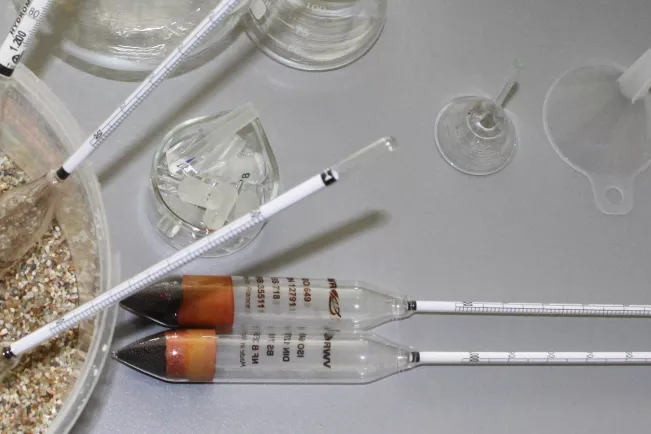Department of Natural Sciences
Physics/Statistics (Compulsory course in the 2nd semester Applied Biology)

Lecture
The course has two parts:
Physics:
Lecture: 2 SWS
Exercises: 1 SWS
Laboratory course: 1 SWS
Lecture:
- Mechanics (kinematics and dynamics, forces, work and energy, momentum)
- Mechanics of liquids and gases
- Thermodynamics (definition of temperature, physical changes of solids and liquids due to temperature changes, ideal gases, kinetic theory of gases, First and Second Law of Thermodynamics, equation of states for real gases and vapors, heat conduction, material transport
→ BSc Applied Biology Download scripts, exercises, group assignment etc. (LEA)
Statistics:
Lecture: 1 SWS
Exercises: 1 SWS
Lecture:
- Samples: parameters of samples; error propagation: random and systematic errors, regression and correlation; linear regression; fitting of parametric functions; direct least square minimisation
- Probability calculus: combinatorics; probability experiments; probability; calculation of probabilities; conditional probabilities; probability density; definition of probability density; distribution functions; parameters of probability distributions; normal distribution
→ Download material for Statistics: scripts, exercises (LEA)
Exercises
Physics exercises:
Exercises:
The concepts and equations of the lecture are applied to real world problems to facilitate the understanding of these topics.
Statistics exercises:
Exercises:
The concepts acquired during the lecture are applied to concrete situations to enhance the students' understanding of the principles involved.
Internship
Physics laboratory course:
In small groups (in general two students per experimental setup), students conduct a range of experiments in the various subject areas of the module. The experiments, cover the subject areas of
- Mechanics (translational motion with air tracks)
- Mechanics of fluids (density determination of liquids)
- Gas laws (gas thermometer)
- Thermodynamics (determination of heat capacities and enthalpies)
By conducting these experiments, students gain some experience in performing quantitative experimental work, including statistical analyses and error analyses (random versus systematic errors, error propagation, linear regression). In addition, the students get a better understanding of the topics of the lecture by applying it to concrete practical examples.
Requirements
For the participation in lectures or exercises are no entry requirements.
For the participation in practical class: successful attendance to the General Safety Instruction as well as the Specific Laboratory Safety Instruction is mandatory.
The specific safety instruction is part of the physics lesson, always in the beginning of the semester.
At the end of the course is a written examination for Physics and Statistics. The cumulative mark of the module consists of a
- written examination in Physics and Statistics (70%)
- assessment of the practical course (30%)
- successful participation in the laboratory exercises is a prerequisite for passing the modular examination.
For the whole module (Physics and Statistics) 6 ECTS are allocated.
More details will be explained during the first lecture.
Literature
Physics:
- Physics in Biology and Medicine, Davidovits, Harcourt Academic Press
- Physics for Pre-Med, Biology, and Allied Health Students, Hademenos, McGraw-Hill
- Physics with illustrative examples from Medicine and Biology, Biological Physics Series
- College physics, Urone, Brooks/Cole, Pacific Grove, CA
- Fundamentals of Physics, Halliday, Resnick, Walker: 6th Ed. Wiley, New York 2001
Statistics:
- Mathematik für Ingenieure und Naturwissenschaftler, L. Papula, Volume 3, 2nd Edition.
- Experimental Methods, Les Kirkup, Wiley, Brisbane 1994
- Primer of Biostatistics, S. A. Glantz: 5th Ed., McGraw-Hill, New York 2002
- Introduction to Statistics for Forensic Scientists, David Lucy, Wiley, 2006
- An Introduction to Error Analysis, Taylor, University Sci. Books,1982
- Fundamentals of Biostatistics, B. Rosner, Duxbury, 2000
Sie haben noch Fragen?

Location
Rheinbach
Room
A 132
Address
von-Liebig-Str. 20
53359, Rheinbach
Telephone
+49 2241 865 530